Welcome to your NCLEX reviewer and practice questions quiz for growth and development. In this nursing test bank, test your competence on the different theories on growth and development. This quiz aims to help nursing students master the concepts of growth and development through these practice questions and NCLEX reviewers.
Growth and Development Practice Quiz
In this section are the practice questions for growth and development. This nursing test bank set includes 50 questions divided into two parts. Included topics are growth and development theories, developmental stages by Erik Erikson, Jean Piaget’s Theory of Cognitive Development, and Sigmund Freud‘s Psychosexual Development.
Quiz Guidelines
Before you start, here are some examination guidelines and reminders you must read:
- Practice Exams: Engage with our Practice Exams to hone your skills in a supportive, low-pressure environment. These exams provide immediate feedback and explanations, helping you grasp core concepts, identify improvement areas, and build confidence in your knowledge and abilities.
- Challenge Exams: Take our Challenge Exams to test your mastery and readiness under simulated exam conditions. These exams offer a rigorous question set to assess your understanding, prepare you for actual examinations, and benchmark your performance.
- You’re given 2 minutes per item.
- For Challenge Exams, click on the “Start Quiz” button to start the quiz.
- Complete the quiz: Ensure that you answer the entire quiz. Only after you’ve answered every item will the score and rationales be shown.
- Learn from the rationales: After each quiz, click on the “View Questions” button to understand the explanation for each answer.
- Free access: Guess what? Our test banks are 100% FREE. Skip the hassle – no sign-ups or registrations here. A sincere promise from Nurseslabs: we have not and won’t ever request your credit card details or personal info for our practice questions. We’re dedicated to keeping this service accessible and cost-free, especially for our amazing students and nurses. So, take the leap and elevate your career hassle-free!
- Share your thoughts: We’d love your feedback, scores, and questions! Please share them in the comments below.
Quizzes on this guide include:
| Quiz No. | Quiz Title | Questions |
|---|---|---|
| Growth and Development Nursing Test Banks | ||
| 1 | Growth and Development NCLEX Challenge Exam | 25 |
| 2 | Growth and Development NCLEX Practice Exam | 25 |
Growth and Development Review
This reviewer is prepared to give you a brief knowledge of growth and development, including the different theories, physiologic changes, hospital reactions by age, and the different developmental milestones.
Theories of Growth and Development
The following are some of the theories involving child development that have been proposed by these well-known theorists:
Erikson’s Theory of Psychosocial Development
- According to Erickson, a human being must go through a series of psychosocial developmental stages that must be balanced throughout the lifespan.
- Each stage is characterized by a psychosocial conflict that must reach a resolution to allow the individual to go on the next phase of development.
Erik Erikson’s 8 Stages of Psychosocial Development
- Trust vs Mistrust: Infancy (birth to 18 months)
- Task: attachment to the mother/caregiver
- Successful outcome: feeling of trust
- Unsuccessful outcome: mistrust, suspicion, uncertainty of the future
- Autonomy vs Shame and Doubt: Early childhood (18 months to 3 years)
- Task: develop a sense of personal control over physical skills and sense of independence
- Successful outcome: feeling of self-control, self sufficiency
- Unsuccessful outcome: lack of independence, feelings of self-doubt
- Initiative vs Guilt: Late childhood (3 to 6 years)
- Task: become purposeful and directive
- Successful outcome: sense of purpose
- Unsuccessful outcome: sense of guilt, self-doubt, and lack of initiative
- Industry vs Inferiority School age (6 to 12 years)
- Task: develop physical, social, and learning skills
- Successful outcome: self-confidence, competence
- Unsuccessful outcome: feelings of inferiority, poor self concept
- Identity vs Role Confusion: Adolescence (12-20 years)
- Task: develop sense of self and personal identity
- Successful outcome: sense of strong identity
- Unsuccessful outcome: self-confusion
- Intimacy vs Isolation: Early adulthood (20-35 years)
- Task: form intimate, loving relationship with other people
- Successful outcome: strong relationship
- Unsuccessful outcome: loneliness, isolation
- Generativity vs Stagnation: Middle adulthood (35 to 65 years)
- Task: achieve life goals and creating positive change for the benefit of others
- Successful outcome: feelings of accomplishment
- Unsuccessful outcome: inability to grow as a person
- Integrity vs Despair: Late adulthood (65 years to death)
- Task: reflection on life
- Successful outcome: sense of fulfillment and integrity
- Unsuccessful outcome: regret, bitterness,dissatisfaction with life
Jean Piaget’s Theory of Cognitive Development
- The theory focuses on concepts of language, scientific reasoning, memory, and moral development.
- According to Piaget, to progress from one stage to the next, the child reorganizes his or her thinking process to bring them close to reality.
4 Stages of Cognitive Development
- Sensorimotor stage (birth to 2 years)
- Present at birth, the infant/child uses reflexes like sucking, grasping, looking, and listening to gain an understanding about the environment.
- Object permanence (objects continue to exist even though it can no longer be seen or heard) and separation anxiety develops in this stage.
- Preoperational stage (2 to 7 years)
- The child begins to use language and think symbolically.
- Egocentrism (inability to see a situation from another person’s point of view) is evident in this stage.
- Comprehends simple abstract but thinking is usually concrete and literal
- Concrete operational stage (7 to 11 years)
- The child can think logically but can only apply it to physical objects.
- The child starts to use concepts of number, time, space, and volume.
- Formal operational stage (11 years to adulthood)
- Individuals demonstrate the ability to think abstractly, reason logically, and draw conclusions.
- Can engage in hypothetical thinking and scientific reasoning.
Sigmund Freud’s Psychosexual Development
- According to Freud, the child’s development goes through a series of psychosexual stages in which the child’s desires become focused on a particular body part.
- Each stage is presented with a conflict that will help build or suppress growth depending on how they are resolved.
Stages of Psychosocial Development
- Oral stage (birth to 1 year)
- Mouth is the center of gratification through sucking, chewing, swallowing, breastfeeding, and biting.
- Improper resolution in this stage, may lead to oral fixation habits such as nail-biting, thumb sucking, smoking, and excessive drinking.
- Anal stage (1 to 3 years)
- Child finds pleasure and sense of control through retention and defecation of feces
- Toilet training is present that provides the child a sense of self-control.
- Parents that are too lenient during toilet training will result in an anal-expulsive personality which includes being messy, disorganized, rebellious, and careless.
- Parents that are too strict or start toilet training too early will result to anal-retentive personality which includes being overly obsessive, and rigid.
- Phallic stage (3 to 6 years)
- Interest in the genital area and masturbation are sources of pleasure in this stage.
- Awareness of sexual difference can result in Oedipus complex (Electra complex in women), an unconscious desire for the parent of the opposite sex while developing a conflict for the parent of the same-sex.
- Latent stage (6 to 12 years)
- Sexual urges diminish and children start to channel their sexual energies in honing their values and developing their new skills to form relationships with other people.
- Fixation in this stage can lead to immaturity and a failure to form relationships as an adult.
- Genital stage (12 years to adulthood)
- Starts with the onset of puberty when physical maturity prepares the body for reproduction.
- Individuals starts to develop sexual and emotional interest towards the opposite sex.
Lawrence Kohlberg’s Theory of Moral Development
- Kohlberg believed that a person can acquire knowledge of moral values through active thinking and reasoning.
Stages of Moral Development
Here are three levels of moral development, with each level consisting of different stages:
Level 1: Preconventional Morality
- Stage 0 (birth to 2 years). Egocentric Judgement: no concept of right or wrong
- Stage 1 (2 to 3 years). Obedience and Punishment: behavior driven by avoiding punishment.
- Stage 2 (4 to 7 years). Individualism and Exchange: behavior is driven by rewards or have favors returned.
- Level 2: Conventional Morality
- Stage 3 (7 to 10 years). Good Boy- Nice Girl Orientation: behavior is determined by social approval.
- Stage 4 (10-12 years). Law and Order Orientation: social rules and laws determine behavior.
- Level 3: Postconventional Morality
- Stage 5: Social Contract and Legalistic Orientation: rules and laws exist for the greater good of all.
- Stage 6: Universal Ethical Principles Orientation: development of own moral principles even if they conflict with the law of the society.
Physiologic growth and development
- Weight. Most babies doubled their weight at the rate of 5 to 7 ounce weekly for 6 months and tripled at 12 months.
- Length. A growth of 1.5 to 2.5 cm is seen monthly from birth to age 6 months while a growth of 1 cm per month is expected from ages 6 to 12 months.
- Fontanel. Anterior fontanel closes by 12 to 18 months of age; Posterior fontanel closes by the end of the second month.
- Head circumference. The average head circumference of a newborn is about 33 to 35 cm, 2 to 3 cm more than chest circumference.
- Teeth. Lower front teeth normally appear by the age of 5 to 9 months while upper front teeth begin to appear by 8 to 12 months. All deciduous teeth (20 in total) will erupt by the 2 ½ years of age.
Developmental Milestones
Here are the important milestones that an infant goes through:
2 to 3 months
- Begin to smile
- Coos, makes gurgling noises
- Turn head toward sounds
- Follow objects with eyes
- Hold head and chest up when prone
4 to 5 months
- Smile spontaneously
- Cooing and babbling when spoken to
- Grasp objects
- Rolls over by self
- Hold head steady, unsupported
6 to 7 months
- Recognize familiar faces and begins to show fear of strangers
- May say vowel sounds when babbling (oh oh) and imitate sounds
- Responds when own name is heard
- Sit with support
- Rolls back and forth and vice versa
- Show feelings of joys and annoyance
8 to 9 months
- Say first words such as (ma-ma-ma, ba-ba-ba)
- Uses index finger and thumb to pick up objects
- Can sit securely unsupported
- Crawls
- Stands, holding on
- Begin to stand without help
10 to 11 months
- Use simple gestures such as waving “bye-bye”
- Walk with support while holding onto objects
- Stand alone
12 months
- Say simple words like “mama” or “dada”
- Get to a sitting position with no help
- Can drink from a cup and hold spoon to feed self
15 to 18 months
- Say several single words
- Understand and follow simple instructions
- Can point to one body part
- Walks alone
- Walk up and down stairs while holding on
- Can help undress oneself
Hospitalized Reaction by age
A summary of the normal developments expected in a child during hospitalization at different age stages:
- Infant and toddler. Characterized by separation anxiety, loss of control (shown in behaviors related to toileting, feeding, bedtime), and fears of bodily pain and injury
- 3 phases of separation anxiety:
- Protest- hours and several days of screaming, crying, and is inconsolable.
- Despair- child becomes withdrawn, hopeless, and apathetic.
- Detachment- occurs after prolonged separation of parent; child appears to have adjusted to the loss; becomes more interested in the environment; appears to be happy and content with caregivers and other children.
- Interventions:
- Encourage parents to stay with and participate in the care as often as possible.
- Continue and maintain the same routine to what the infant/toddler is accustomed to.
- Provide comfort measures such as their favorite toy, pacifier for oral and sucking stimulation, and blanket.
- Provide a safe environment especially during temper tantrums such as side rails up, keeping equipment out of reach.
- Allow toddler with opportunities to make choices to gain some control.
- Provide age appropriate distraction and pain reducing techniques.
- 3 phases of separation anxiety:
- Preschooler. separation anxiety decreases, fears loss of family routine and schedules, and fear of bodily injury from invasive procedures; believes that hospitalization is a punishment for bad actions.
- Interventions:
- Encourage parents to stay with and participate in the care as often as possible.
- Acknowledge and allow expression of fears and anger
- Explain procedures in simple terms
- Encourage interaction and play with other children of the same age
- Encourage the preschooler to be independent
- Bring a familiar items with the child
- Continue to set normal limits and provide structure
- Interventions:
- School age. Fears of getting behind in school, fear of disability and death, loss of control and independence, separation from family and friends, child may ask many actions and relate his or her actions with the cause of condition.
- Interventions:
- Explain illness, and treatment to child and patent (use body diagrams, models or videotapes)
- Encourage independence and provide choices as much as possible
- Allow participation in discussion and expression of feelings and fears
- Continue doing school work/assignments if possible
- Provide privacy
- Set limits, and establish routines
- Interventions:
- Adolescence. Experience fear of being different, concerns with appearance, fears of separation from friends, loss of privacy and independence, may exhibit withdrawal and noncompliance with the treatment regimen.
- Interventions:
- Encourage questions and open discussion regarding the effect of illness or treatment in their appearance and relationship
- Provide clear information about the condition and treatment (may use body diagrams) and involve them in decision making as much as possible
- Maintain privacy such as wearing pajama instead of gown
- Allow visitation from peers if possible
- Encourage interaction with friends and others in the same age group
- Interventions:
Car Seats
- One of the leading causes of physical injury and death among children is motor vehicle accidents. An effective measure to prevent these injuries is the use of protective equipment such as car seats. Choosing the right car seat will depend on the age, weight, and developmental needs of the child.
Types of Car Seats
- Rear-facing car seats (birth until the age of 2-4 yrs). Infants and toddlers should be placed in a rear-facing car seat until they reach the maximum weight or height permitted by their car safety seat manufacturer.
- Forward-facing car seat (until at least age 5). When the children start to outgrow their rear-facing seat, they should be restrained in a forward-facing car seat until they reach the maximum weight or height restriction of their car seat.
- Booster seat. Once the children outgrow their forward-facing seat, they should be buckled in a booster seat until seat belts fit properly. This usually occurs when the children are 4 feet and 9 inches tall and age between 8-12.
- Seat belt. A shift to a seat belt is allowed when the child can sit with his or her back straight against the vehicle seat back cushion and the knees are bent over the edge with the absence of slouching. Children under age 13 should be properly buckled in the back seat.
Recommended Resources
Recommended books and resources for your NCLEX success:
Disclosure: Included below are affiliate links from Amazon at no additional cost from you. We may earn a small commission from your purchase. For more information, check out our privacy policy.
Saunders Comprehensive Review for the NCLEX-RN
Saunders Comprehensive Review for the NCLEX-RN Examination is often referred to as the best nursing exam review book ever. More than 5,700 practice questions are available in the text. Detailed test-taking strategies are provided for each question, with hints for analyzing and uncovering the correct answer option.
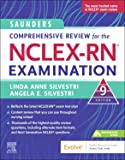
Strategies for Student Success on the Next Generation NCLEX® (NGN) Test Items
Next Generation NCLEX®-style practice questions of all types are illustrated through stand-alone case studies and unfolding case studies. NCSBN Clinical Judgment Measurement Model (NCJMM) is included throughout with case scenarios that integrate the six clinical judgment cognitive skills.
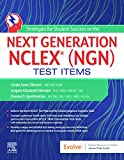
Saunders Q & A Review for the NCLEX-RN® Examination
This edition contains over 6,000 practice questions with each question containing a test-taking strategy and justifications for correct and incorrect answers to enhance review. Questions are organized according to the most recent NCLEX-RN test blueprint Client Needs and Integrated Processes. Questions are written at higher cognitive levels (applying, analyzing, synthesizing, evaluating, and creating) than those on the test itself.
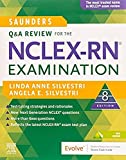
NCLEX-RN Prep Plus by Kaplan
The NCLEX-RN Prep Plus from Kaplan employs expert critical thinking techniques and targeted sample questions. This edition identifies seven types of NGN questions and explains in detail how to approach and answer each type. In addition, it provides 10 critical thinking pathways for analyzing exam questions.
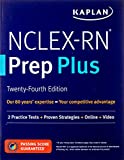
Illustrated Study Guide for the NCLEX-RN® Exam
The 10th edition of the Illustrated Study Guide for the NCLEX-RN Exam, 10th Edition. This study guide gives you a robust, visual, less-intimidating way to remember key facts. 2,500 review questions are now included on the Evolve companion website. 25 additional illustrations and mnemonics make the book more appealing than ever.
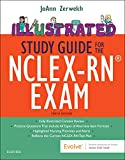
NCLEX RN Examination Prep Flashcards (2023 Edition)
NCLEX RN Exam Review FlashCards Study Guide with Practice Test Questions [Full-Color Cards] from Test Prep Books. These flashcards are ready for use, allowing you to begin studying immediately. Each flash card is color-coded for easy subject identification.
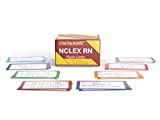
Additional Information
Other Quizzes:
An investment in knowledge pays the best interest. Keep up the pace and continue learning with these practice quizzes:
- Nursing Test Bank: Free Practice Questions UPDATED!
Our most comprehenisve and updated nursing test bank that includes over 3,500 practice questions covering a wide range of nursing topics that are absolutely free! - NCLEX Questions Nursing Test Bank and Review UPDATED!
Over 1,000+ comprehensive NCLEX practice questions covering different nursing topics. We’ve made a significant effort to provide you with the most challenging questions along with insightful rationales for each question to reinforce learning.
Further Reading
Additional reading materials and sources for growth and development:
- Ball, J. W., DrPH, R. N., Bindler, R. M., Cowen, K. J., & Shaw, M. R. (2013). Child health nursing. Upper Saddle River: Prentice Hall.
- Kuokkanen, L., & Leino‐Kilpi, H. (2000). Power and empowerment in nursing: three theoretical approaches. Journal of advanced Nursing, 31(1), 235-241.
- Sacco, R. G. (2013). Re-envisaging the eight developmental stages of Erik Erikson: the Fibonacci life-chart method (FLCM). Journal of Educational and Developmental Psychology, 3(1), 140-146.
- Thies, K. M., & Travers, J. F. (2008). Quick look nursing: growth and development through the lifespan. Jones & Bartlett Publishers.
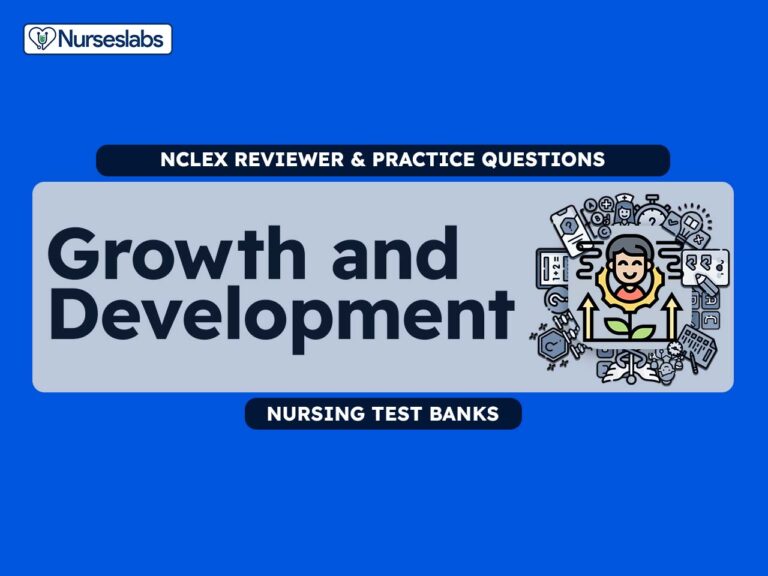
Very helpful and insightful.Thank you